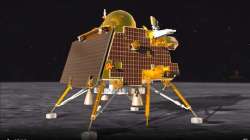Chandrayaan-3: ISRO envisions lander and rover's mission life likely to be extended beyond one lunar day
The scientists at the space agency believe that Chandrayaan-3's lander and rover will come back to life when the sun rises again on the Moon, to carry on with the experiments and studies there.

After the successful deployment of Chandrayaan-3 on the Moon, the Indian Space Research Organisation (ISRO) is anticipating that the lander and rover's mission life will not be constrained to just one lunar day or 14 earth days. The scientists at the space agency believe that Chandrayaan-3's lander and rover will come back to life when the sun rises again on the Moon, to carry on with the experiments and studies there.
At 6:04 pm on Wednesday, the lander (Vikram) successfully accomplished one of the stated objectives of the Chandrayaan-3 mission by making a soft touchdown on the lunar surface. According to officials, the lander and rover have now been deployed, and their systems are prepared to conduct experiments one after the other in order to finish them within 14 days before total darkness and very cold weather descend on the Moon.
What did ISRO say of rover?
ISRO had earlier said the 26 kg six-wheeled rover was scheduled to descend from the lander's belly onto the Moon's surface, using one of its side panels which acts as a ramp. The lander and rover -- with a total mass of 1,752 kg -- are designed to operate for one lunar daylight period (about 14 Earth days) to study the surroundings there. However, ISRO officials do not rule out the possibility of them coming back to life for another lunar day.
Explaining what would happen after the lander's soft landing and deployment of the rover, ISRO Chairman S Somnath had earlier said, "After this, all the experiments (by payloads on lander and rover) will take place one after the other -- all of which have to be completed in just one day on the Moon, which is 14 days on Earth."
Noting that as long as the sun shines, all the systems will have their power, he said, "The moment the sun sets, everything will be in pitch darkness, the temperature will go as down as low as minus 180 degrees Celsius. So it is not possible for the systems to survive, and if it survives further, then we should be happy that once again it has come to life and we will be able to work on the system once again. We hope it would happen that way," he added.
What would rover do on Moon's surface?
The rover will carry out in-situ chemical analysis of the lunar surface during the course of its mobility. It would study the surface of the Moon through its payload APXS (Alpha Particle X-Ray Spectrometer) to determine the elemental composition of lunar soil and rocks around the lunar landing site.
Another payload on the rover, the Laser-Induced Breakdown Spectroscope (LIBS), will derive the chemical composition and infer mineralogical composition to further enhance understanding of the lunar surface. According to ISRO officials, the Moon's south pole region is also being explored because there is a possibility of water being present in permanently shadowed areas around it, according to ISRO officials. The rover will send the data to the lander which will then send it to Earth.
India's lunar mission
It should be mentioned here that India’s Moon mission Chandrayaan-3 touched down on the lunar south pole at 6:04 pm on Wednesday, August 23. In a big boost to India's space prowess, the Lander Module comprising the lander (Vikram) and the rover (Pragyan), made the soft landing near the south polar region of the Moon, less than a week after a similar Russian lander crashed. The Rs 600 crore Chandrayaan-3 mission was launched on July 14 onboard Launch Vehicle Mark-III (LVM-3) rocket, for a 41-day voyage to reach near the lunar south pole.
(With inputs from PTI)

